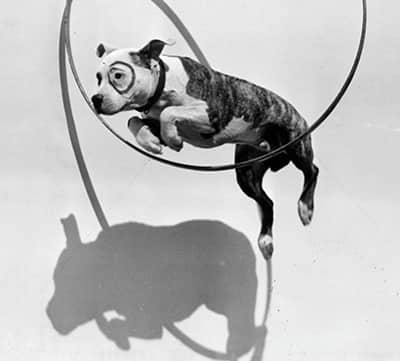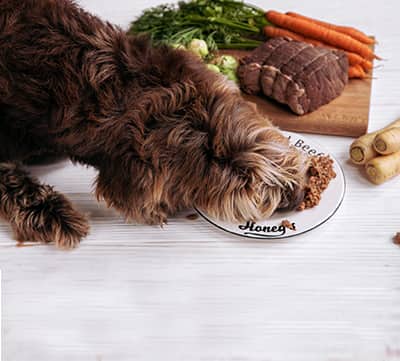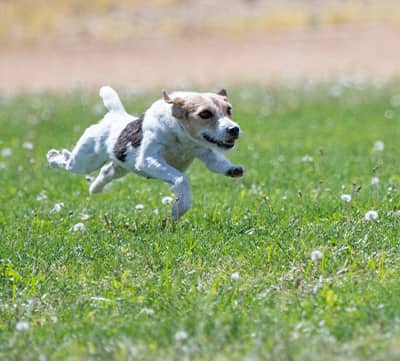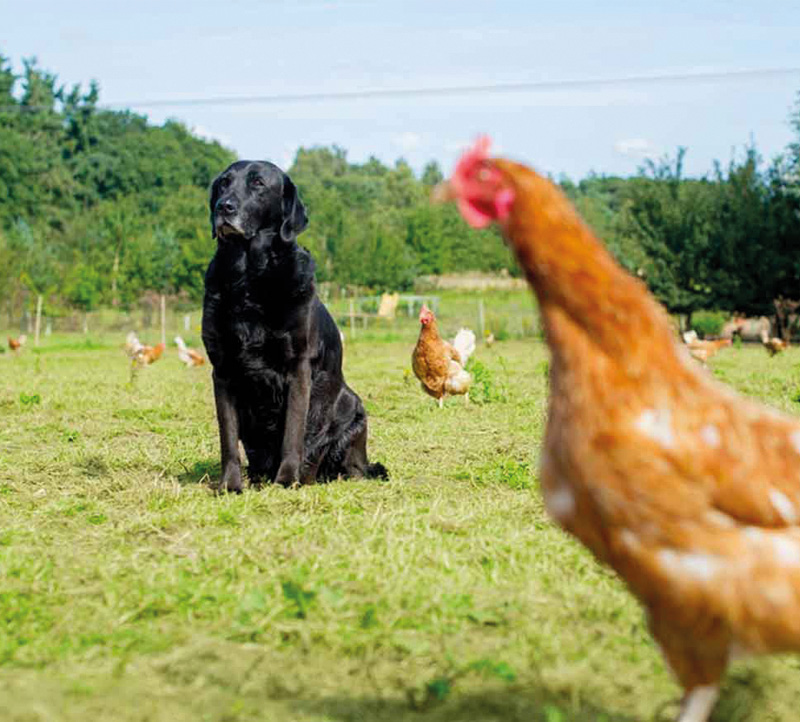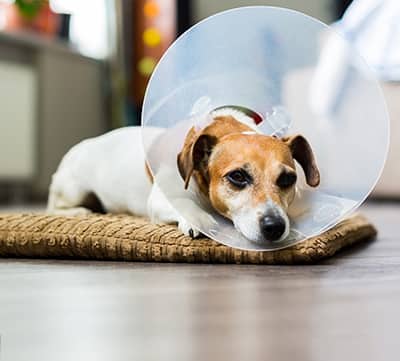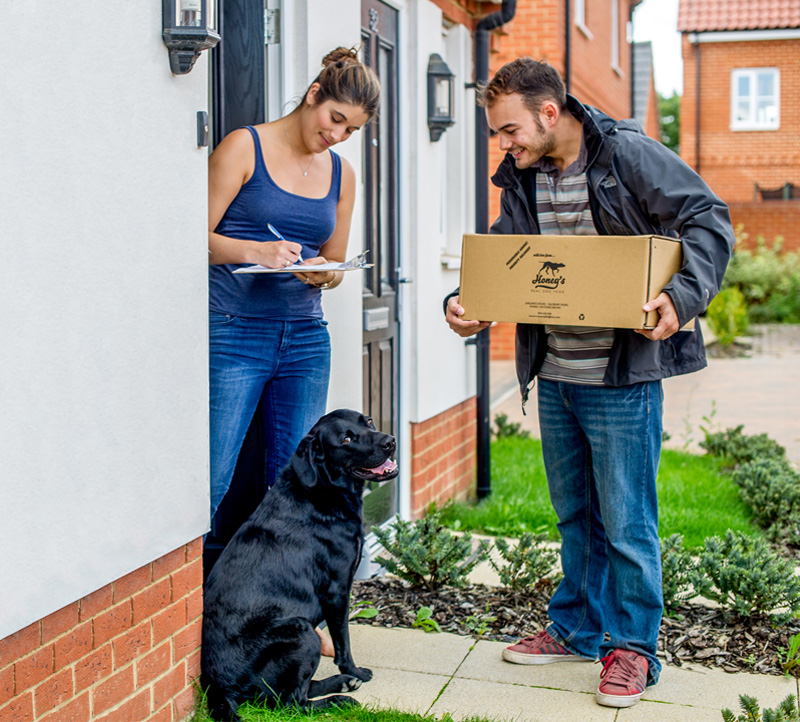Making the switch to the Lucky Dog Diet
‘At last! This is the very food I have been longing for. Thank you, thank you.’ Most dogs welcome the switch to the Lucky Dog Diet with open paws (and open jaws!) but from time to time (I would guess, maybe, one dog in a hundred) a dog will turn its nose up and generally become sniffy at the change in diet.
Why does this happen?
I have found that generally it is the really intelligent dogs from loving homes that are more likely to take a stand-offish attitude to the introduction of the Lucky Dog Diet. My guess is that their hunger for attention is greater than their hunger for food. Being smart, they realise that if they don’t eat you’ll make a fuss of them and this makes them happy. Sometimes, too, dogs become addicted to the high carbohydrate, high sugar, rancid fat taste of kibble or tinned food (in the same way a child may become addicted to junk food) and they object, on principle, to the move to a healthier option. Whatever the cause, there is no need to worry, as I explain below.
Switching options
Be firm
A dog can go up to a week without food and be none the worse for it. Give your dog a single chance to eat every 24 hours, and if he or she doesn’t pounce on it with enthusiasm the moment you put the bowl down, lift it straight back up and wait another day. (Anyway, it is not a good idea to ever leave food down for your dog as snacking puts a strain on their digestive system.) Too soft-hearted for such a firm approach? Keep reading.
Mixing
Slowly start adding raw food to whatever it is you normally feed, increasing the amount every day until it is 100% raw after one or two weeks. This gives the dog’s stomach time to adjust to the change. If the dog is regurgitating the food then, having checked it isn’t a medical issue, extend the period over which you make the switch. It doesn’t really matter if it takes a month or more.
Cooking
Take the raw food and cook it in a pan (not a microwave and not the bones). Every day cook it slightly less until it is raw. This gives the dog’s stomach time to adjust to the change from sterile, processed food.
Tripe
Fast for a day and then make the switch immediately, but only feed your dog green tripe to begin with. Dogs find this incredibly easy to digest and it contains all the nutrients they need.
Dogs and vegetables
Some dogs love vegetables; others don’t, and the ones who don’t may decline to eat their food for this reason. The solution? Give in to them! Remove vegetable from their diet completely and wait for a week or two before gradually reintroducing it. Another approach is to pour a little real gravy or break an egg over the food before serving it, as this will disguise the taste.
Other things to watch out for
There are other issues that you should watch out for during the switchover period.
Itchy ‘hot’ spots
Itchy hot spots on the dog suggest that the food you are providing is a little too rich in one or more specific proteins. Vary the protein source (switch to different meats) or increase the fat and/or vegetable content.
Regurgitation immediately after eating
Regurgitation immediately after eating is almost always caused by a conditioned reflex. The dog’s stomach is expecting the normal food and has prepared the wrong kind of enzymes to digest it. When the new food turns up, the system rejects it. It is quite normal in nature for a dog to eat something, vomit it up and eat it again. It is, of course, up to you whether you allow this. But you shouldn’t panic. The solution to this sort of vomiting is, initially, patience and then to use one of the switching options mentioned above.
Incidentally, dogs may also vomit bones because they aren’t used to eating them, and some people suspect that dogs vomit a meal that they really enjoyed eating so that they can have the pleasure of eating it again! If you have been feeding the Lucky Dog Diet for a couple of weeks and the dog suddenly vomits, this may be an attempt to rid the body of toxins and is not unusual. Obviously, if your dog is vomiting frequently you should check with your vet that there isn’t any serious underlying health problem.
Soft stools
You shouldn’t panic if your dog’s stools are runny. It is probably caused by the change in diet and will pass in a few days. It could also be the result of not enough bone in the diet as it is the bone that tends to make the stools firmer. The solution to runny stools is, initially, patience and then to use one of the switching options mentioned above. You could also increase the bone element of the dog’s diet. If your dog seems to have a problem with a particular ingredient try it for two or three days and then drop it and come back to it later.
A word about canine tummy upsets
There is a huge difference between soft or runny stools and diarrhoea. It is normal, when switching diet, for dogs to experience soft or runny stools and it can occur if they aren’t eating enough bone. True diarrhoea is virtually liquid – like soup. A reliable remedy (apart from increasing the amount of bone you are feeding) is to give the dog slippery elm. Some people recommend mashed boiled sweet potato (possibly with an egg) to firm up stools. If you are worried, return the dog to the old diet and start again when things have settled down. At what point do you call in a vet? In the case of runny stools don’t wait more than a week. In the case of true diarrhoea you probably shouldn’t delay more than 24 hours. Incidentally, true diarrhoea is not caused by raw food per se but will almost certainly be the result of either a parasite or gastrointestinal problem. If the latter, all that has happened is that the raw feeding has exposed the underlying problem.
Vicky Marshall
Author of the Lucky Dog Weight Loss Plan
For more information and advice on any aspect of canine health and nutrition please contact Honey’s – we’ll be happy to help even if you never, ever plan to become a customer.
Web: www.honeysrealdogfood.com
Email: info@honeysrealdogfood.com
Telephone: 01672 620 260
